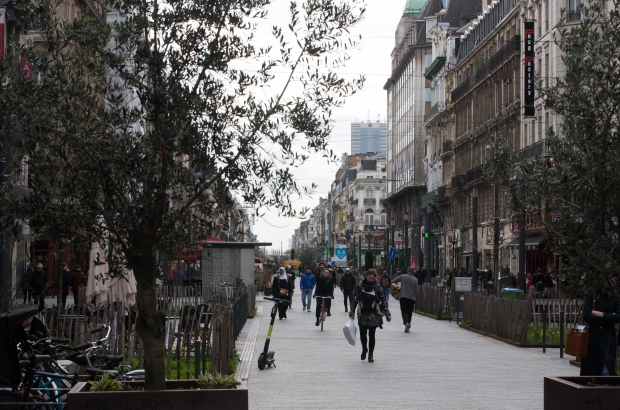- Daily & Weekly newsletters
- Buy & download The Bulletin
- Comment on our articles
Buses banned from using section of Brussels pedestrian zone
Stib buses will no longer pass through a section of the pedestrian zone in Brussels city centre in the future. The decision has been made on safety grounds and will also bring the stretch between Rue des Teinturiers and Place Fontainas in line with the rest of the zone. It will also remove the need to constantly replace the road surface in the area.
When the pedestrian zone was built on the central avenues, there was at least one anomaly in the plan. The southernmost part of the zone would still allow cars to pass through it via a single lane.
Last year, cars were banned from the zone, but Stib buses continued to use the road. This led to severe damage to the surface, which often had to be repaired. The City of Brussels has now gone a step further by deciding that buses are completely banned from the pedestrian zone.
"After consultation with Stib, the local traders and the fire brigade, we have decided to divert the bus 48 route along the Rue du Midi," explained Bart Dhondt, the councillor responsible for public works and mobility.
“The bus is already temporarily travelling on that route, and it has not caused any major problems." The bus 95 will continue to use a short loop road on a small section of the zone between Plattesteen and Rue des Teinturiers.
"Without buses, first and foremost, pedestrians will be better able to enjoy the zone," Dhondt explained. "It's also safer. Until now, Stib drivers have had to drive very carefully, because there might have been children playing on the route." The technical problems with the road surface also played a role.
The move represents another step towards reducing the number of vehicles in the city centre. It was also previously decided to make Place De Brouckère car-free. The city also banned cars from the Rue du Jardin des Olives and the Rue du Marché au Charbon. "And with Rue Sainte-Catherine becoming car-free, we made a connection between the pedestrian zone and the Marché aux Poissons," said Dhondt.
The city council was criticised last week by the air quality collective Filter Café Filtré over a lack of progress in the past three years to improve the traffic situation on the Rue de Flandre, where the actions of the citizens' collective started. "But we are working on a more car-free city centre, as the changes to the pedestrian zone show," stated Dhondt.
In the meantime, the city has a proposal ready for the Rue de Flandre to turn it into an official school street. Dhondt wants to submit that plan to the neighbourhood before the summer recess.



















